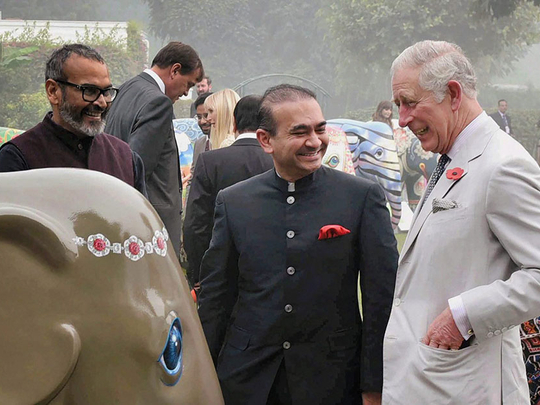
India is dealing with what likely is the biggest fraud to hit the country’s banks, with companies owned by diamond merchants Nirav Modi and his uncle Mehul Choksi alleged to have swindled the state-run Punjab National Bank (PNB) of more than Rs110 billion (Dh6.2 billion or $1.77 billion).
Indian banks could take a hit of more than $3 billion from loans and corporate guarantees provided to diamond companies allegedly involved in the fraud at PNB, investigators said yesterday.
In its complaint to the Central Bureau of Investigation, PNB alleged that the fraud was led by Modi, who has dressed top actors including Kate Winslet and Priyanka Chopra. Modi is in New York City, and the Indian ministry of external affairs on Friday suspended his passport.
- Nirav Modi | Diamond merchant
Here is how Modi and his associates allegedly pulled off the biggest scam in India’s banking history:
1. It was at a Punjab National Bank branch in south Mumbai that a lone middle-aged manager, later aided by his young subordinate, engineered fraudulent transactions totalling about $1.8 billion from 2011 to 2017. According to court documents filed by the CBI, the bank branch deputy manager Gokulnath Shetty issued a series of fraudulent Letters of Undertaking — essentially guarantees sent to other banks so that they would provide loans to a customer, in this case a group of Indian jewellery companies. The fraudulent practice started in 2011, with a single letter of undertaking (LoU) worth around Rs8 billion.
2. These letters were sent to overseas branches of banks, thought to be almost all Indian, that would then lend money to the jewellery firms. Shetty did so using the bank’s SWIFT system to log in with passwords that allowed him, and in at least some instances a more junior official, to serve as both the person who sent messages and as the person who reviewed them for approval. Shetty, who has been arrested by the CBI, told investigators that he obtained a Level-5 password to the SWIFT system without any authorisation so that he could issue Letters of Undertaking (LoUs) and Foreign Letters of Credit (FLCs). Shetty made the startling revelations when CBI investigators questioned him about the modus operandi of providing guarantee to other banks. Shetty also admitted that he shared the password with other PNB employees and directors of Nirav Modi’s company.
3. The Level 5 password was the key allowing him to reach out to several banks to release the money to the Nirav Modi and Gitanjali groups through the SWIFT system. The Society of Worldwide Interbank Financial Telecommunication (SWIFT), is a system to send instant messages. Once a foreign bank or a foreign branch of a bank gets the LoU via the SWIFT message, it instantly disburses the loan to the borrower. After entering the transactions on SWIFT, Shetty — who worked at the same branch from 2010 to 2017 despite normal bank practices of regular rotations — did not record them on the bank’s internal system. Because PNB’s internal software system was not linked with SWIFT, employees were expected to manually log SWIFT activity. If that was not done, the transactions did not show up on the bank’s books. All-together, there were at least 150 such fraudulent Letters of Undertaking during a seven-year period, according to the CBI.
4. When the Modi group companies did not repay the first Rs8 billion, the bank ought to have stepped in and booked a default. Instead, the two PNB employees issued more LoUs on behalf of the bank, asking other banks to give out fresh loans to the companies. This practice continued well until January 2018. The case came to light when Modi’s companies sought a fresh loan with PNB on January 5. By then, the officials who were allegedly conniving with them had retired and the new ones asked for 100 per cent cash margin to issue the letters. When Modi’s companies insisted that they had used the facility before, PNB management was alerted.
5. On January 29, Punjab National Bank filed an initial criminal complaint with the CBI, accusing Modi and others of defrauding the bank and causing it a loss of 2.8 billion Indian rupees (more than $43 million). But as more details surfaced about what is alleged to have happened at the state-run bank, which was founded in 1894, the stakes have gotten higher. Bank executives say the amount tallied by working back through internal records is $1.77 billion.
6. Nirav Modi left India on January 1 — long before the CBI received a complaint from PNB about the fraud. His brother Nishal, a Belgian citizen, also left the country on January 1, while wife Ami, a US citizen, and business partner Mehul Choksi, the Indian promoter of Gitanjali jewellery chain, left the country on January 6. The agency issued a lookout circular against all the four after registering the first FIR against them, officials said. A lookout circular is issued by enforcement agencies to all exit and entry ports to inform them about the movement of an accused.
7. The CBI is questioning Vipul Ambani, the chief financial officer of Modi’s Fire Star diamond company. Ambani, understood to be a relative of Reliance founder Dhirubhai Ambani, has been holding the post for the past few years, officials said. The agency also continued interrogating more PNB officials and an authorised signatory of Modi’s company, taking the total number of officials facing questioning to 11.
— Compiled from agencies












